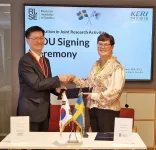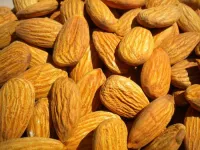(Press-News.org) While both men and women have historically been accused of the malicious use of magic, only around 10–30% of suspected witches were men by the 16th and 17th centuries.*
This bias towards women is often attributed to misogyny as well as economic hard times. Now, a Cambridge historian has added another contributing factor to the mix.
Dr Philippa Carter argues that the types of employment open to women at the time came with a much higher risk of facing allegations of witchcraft, or maleficium.
In a study published in the journal Gender & History, Carter uses the casebooks of Richard Napier – an astrologer who treated clients in Jacobean England using star-charts and elixirs – to analyse links between witchcraft accusations and the occupations of those under suspicion.
Most of the jobs involved healthcare or childcare, food preparation, dairy production or livestock care, all of which left women exposed to charges of magical sabotage when death, disease or spoilage caused their clients suffering and financial loss.
“Natural processes of decay were viewed as ‘corruption’. Corrupt blood made wounds rankle and corrupt milk made foul cheese,” said Carter, from Cambridge’s Department of History and Philosophy of Science.
“Women’s work saw them become the first line of defence against corruption, and this put them at risk of being labelled as witches when their efforts failed.” This was in contrast to men’s work, which often involved labour with sturdy or rot-resistant materials such as iron, fire or stone.
Moreover, women often worked several jobs, usually in the heart of their communities – criss-crossing between homes, bakehouses, wells, marketplaces – rather than off in fields or workshops.
“The frequency of social contact in female occupations increased the chance of becoming embroiled in the rifts or misunderstandings that often underpinned suspicions of witchcraft,” said Carter. “Many accusations stemmed from simply being present around the time of another’s misfortune.”
“Women often combined multiple income streams, working in several households to make ends meet: watching children, preparing food, treating invalids. They worked not just in one high-risk sector, but in many at once. It stacked the odds against them.”
As part of a decade-long project at Cambridge University, over 80,000 of the case notes scribbled down by the astrologer-doctors Richard Napier and Simon Forman were catalogued and digitised.
Napier serviced the physical and mental health needs of ordinary people from the area surrounding his Buckinghamshire practice, taking reams of personal notes on the woes of his clients. His records reveal everyday attitudes to magic in the decades before the English Civil War.
“While complaints ranged from heartbreak to toothache, many came to Napier with concerns of having been bewitched by a neighbour,” said Carter. “Clients used Napier as a sounding board for these fears, asking him for confirmation from the stars or for amulets to protect them against harm.”
“Most studies of English witchcraft are based on judicial records, often pre-trial interrogations, by which point execution was a real possibility. Napier’s records are less engineered. He seems to have kept these notes only for his own reference,” Carter said.
“The astrologer’s services were accessible to the average person. People might visit him to stress-test their theories or look for magical solutions, rather than attempt a risky lawsuit. Napier’s notes allow us access to witchcraft beliefs at a grassroots level, as suspicions bubbled up in England’s villages.”
Carter was able to use the now-digitised casebooks to trawl through his notes for suspected bewitchments, which made up only 2.5% of Napier’s total casefiles.
Between 1597 and 1634, Napier recorded 1,714 witchcraft accusations. The majority of both accusers and suspects were women, although the ratio of female suspects was far higher.**
Some 802 clients identified the suspected witches by name, and 130 of these contained some detail about the suspect’s work.
Six types of work featured regularly across the 130 cases: food services, healthcare, childcare, household management, animal husbandry, and dairying. Such forms of labour were either regularly or almost exclusively the domain of women.
Dairy was symbolically tied to women as “milk-producers”. Carter found 17 cases of magical spoliation of dairy, and 16 involved women only. For example, Alice Gray suspected her neighbours when cheese began to “rise up in bunches like biles [boils] &… heave & wax bitter”. Failures in brewing and baking were also attributed to female witchcraft.
Women often managed food supplies – a power that bred suspicion. Many tales of tit-for-tat maleficium in Napier’s notes derived from spurned requests for food. “Women were both distributers and procurers of food, and failed food exchanges could seed suspicions,” said Carter.
One potential witch, Joan Gill, gained her reputation after her husband consumed milk she had been saving, and the spoon he supped it with lodged itself in his mouth overnight.
Not just denying others food but also supplying it could end in accusation. Nine out of ten suspects who sold food were women, with 25 accusations resulting from a bout of sickness after being fed.
Many women practised as local healers, or “cunning folk”, but this too was a risky occupation: suspicions arose when treatments failed. One male customer, troubled with “a great sorenes [in] his privy [private] partes”, told Napier a female healer had “wewitched him” after he sought a second opinion.
Some of the riskiest work was in what we now call “caring professions”, still dominated by women today: midwifery, attending to the sick or elderly, childminding, and so on. For example, thirteen suspects had cared for the accuser in her childbed.
Infant mortality was high, and the prospect of losing a child often motivated allegations. Over 13% of all recorded witchcraft accusations naming a suspect involved a victim under the age of 12.
Loss of sheep and cattle was also a common cause of accusation. Just over half of livestock workers at the time were women. This parity can be seen in accusers (28 men and 28 women) but not suspects (15 men and 91 women). “Napier’s casebooks suggest that disputes between men over livestock could get deflected onto women,” said Carter.
“An early modern housewife was responsible for managing the health of livestock as well as humans; she made the poultices and syrups used to treat both. When an animal sickened strangely, this could be interpreted as a malefic abuse of her healing skills.”
"Gendered divisions of labour contributed to the predominance of female witchcraft suspects,” added Carter. “In times of crisis, lingering suspicions could erupt as mass denunciations. England’s mid-17th-century witch trials saw hundreds of women executed within the space of three years.
“Every Halloween we are reminded that the stereotypical witch is a woman. Historically, the riskiness of ‘women’s work’ may be part of the reason why.”
Notes:
*In mainland Europe, the British Isles and New England in the US.
** Of the 802 accusers in Napier’s records, 500 were female and 232 were male. The gender of the remaining 70 was not recorded. Among the 960 suspects identified by this group of accusers, 855 were female and 105 were male. Collectively, this group of suspects was accused of at least 1,090 separate accounts of maleficium.
The physical calf-bound volumes of Richard Napier’s casebooks are housed in the University of Oxford’s Bodleian Library.
Examples from the casebooks used in the latest analysis
A female healer is suspected of witchcraft:
CASE46520
Mrs Pedder the younger of Potters Perry. 33 years (old). April 30 Thursday 11.30 p.m. 1618.
Has not had the right course of her body these 3 years. Fears a consumption & (asks) what is good to keep her from it. Urine very good.
Would have a purge for herself & her husband who fears his father's disease. (He) cares not for meat (food). Is jealous of his wife (she) being very honest & chaste. & (he) is sometimes lunatic & mad. 4 years & a half, every 3 or 4 days. He thinks that he is bewitched with (by) one, a woman that gave his mother physick (medicine).
A young woman suffering perinatal ill health suspects her former midwife:
CASE15411
Sybil Fisher of Cogenhoe. 24 years (old). August 1. Monday 12.15 p.m. 1603
[Astrological chart] lightheaded (delirious).
Lightheaded, laughs, but at first took it with a weeping. Looks ghastly. Fleering (scornful) looks. Sets her teeth. One night did nothing but swear and curse.
Sybil Fisher. She knows not of her husband’s coming for her, knows nobody. They bind her hands and feet. When she is loose she is so strong that they cannot deal with her. Sings idle songs. Desires to dance. She had 2 midwives, the first unskilful, the 2nd froward (grumpy) & would not meddle with her because she was not first sent (for). Her suspected to be a witch. The woman well laid but a week after fell into these fits & at first speaking of her 2nd midwife said ‘what doest thou there with thy black hen?’ & such like speeches.
Man suspects former shepherdess of witchcraft:
CASE75057
John Johnson 58 years (old). July 11. Wednesday 9.50 a.m 1632. of Doddington by Wellingborough. Shepherd.
A fortnight since was taken in his knee. (It is) swelled & runs up to his thighs & back & (he) cannot rise. A bad stomach.
Back thighs hucklebone (hipbone) & knee. Cannot stir (move) nor rise nor help him(self).
Suspects witchcraft. Agnes Watts kept his sheep two years before. This shepherd much suspects (her). Lost a Cow.
END
Witchcraft accusations an ‘occupational hazard’ for female workers in early modern England
2023-09-19
ELSE PRESS RELEASES FROM THIS DATE:
China global Merged Surface Temperature dataset (CMST) reveals 2023 on Track to Be Hottest Year Ever
2023-09-19
The climate crisis is reaching unprecedented levels of urgency as global temperatures soar to record-breaking heights, with July 2023 marking another alarming milestone. United Nations Secretary-General António Guterres declared it a "disaster for the whole planet," emphasizing that the era of "global warming" has given way to an era of "global boiling." This alarming assessment is supported by recent findings from Professor Qingxiang Li 's team at the School of Atmospheric ...
Moderate to vigorous physical activity early in the day influences weight management, health outcomes
2023-09-19
ROCKVILLE, Md.—Even though epidemiological evidence has been controversial regarding the optimal timing of physical activity for weight management, the hours of 7 a.m. to 9 a.m. appear to be the most favorable time of day to enhance the association between daily moderate to vigorous physical activity and obesity, according to a new analysis published in Obesity, The Obesity Society’s (TOS) flagship journal.
“Our study provided a novel tool to explore the diurnal pattern of physical activity and to investigate its impact on health outcomes,” said Tongyu Ma, PhD, assistant professor, Health Sciences Department, Franklin Pierce University, Rindge, ...
Korea Electrotechnology Research Institute (KERI) and Research Institutes of Sweden AB (RISE) Ink MoU to Advance Cooperation in Science and Technology
2023-09-19
Korea Electrotechnology Research Institute (KERI) and Research Institutes of Sweden AB (RISE) have officially entered into a Memorandum of Understanding (MoU) aimed at enhancing collaborative research in the field of national strategic technologies. The signing ceremony took place at RISE in Stockholm, Sweden on Friday, September 15, 2023.
RISE, recognized as Europe’s largest state-owned research institute, is composed of 30 private and government-funded research institutes, along with more than 130 government-designated testing agencies. It also boasts a workforce ...
Study finds the placenta holds answers to many unexplained pregnancy losses
2023-09-19
New Haven, Conn. — Yale researchers have shown that placental examination resulted in the accurate pathologic determination of more than 90% of previously unexplained pregnancy losses, a discovery that they say may inform pregnancy care going forward.
The findings were reported Sept. 19 in the journal Reproductive Sciences.
There are approximately 5 million pregnancies per year in the United States, with 1 million ending in miscarriage (a loss occurring prior to 20 weeks of gestation) and over 20,000 ending in stillbirth at or beyond 20 ...
Keeping Vilsmeier reagent in the flow: From toxin to medicine in one go
2023-09-19
The Vilsmeier reagent is necessary for producing a large range of pharmaceuticals, but its unstable nature and toxic precursor phosgene are challenges for its use. A new process that efficiently produces phosgene, the Vilsmeier reagent and the desired products in one flow is poised to make the industry greener and safer.
For the production of many active pharmaceutical ingredients, a chemical called Vilsmeier reagent is necessary, but it is extremely unstable. That's why it is produced on-site and on-demand wherever possible. In addition, the currently used methods for producing the ...
How does smoking tobacco and cannabis affect depression risk?
2023-09-19
People who use both cannabis and tobacco have significantly higher rates of depression and anxiety than those who use either substance alone or not at all, according to a new study by UC San Francisco researchers.
The study, published Sept. 13, 2023 in the online journal PLOS ONE, comes amid expanding legalization of cannabis products, resulting in more dual use with tobacco nationwide. Earlier studies relied on data collected before the legalization trend, prompting the need for a new analysis.
Understanding the association between the use of both drugs and mental health ...
Researchers find association between vaping and asthma among US adolescents
2023-09-19
A new study from the Texas A&M University School of Public Health suggests that vaping increases the risk of asthma in adolescents who have never smoked conventional tobacco products.
Vaping, or the use of electronic cigarettes (e-cigarettes), among adolescents has grown dramatically over the past several years. Although e-cigarettes have fewer toxins than regular cigarettes, they still contain a mixture of harmful chemicals and raise the risk of respiratory diseases.
In this new study, which was published in Preventive Medicine, researchers analyzed data from a national survey of youth to ...
New blood marker can identify Parkinsonian diseases
2023-09-19
Researchers at Lund University are publishing their findings in the prestigious journal Nature Aging.
The marker in question is called DOPA decarboxylase (DCC). In the current study, DCC was found to be elevated in individuals with Parkinson's disease as well as in people with other diseases that result in dopamine deficiency in the brain. However, the marker was normal in other brain diseases such as Alzheimer's disease. The researchers even noticed that DCC was elevated in individuals with Parkinson's many years before they developed any symptoms.
”We ...
MSU researchers receive 12 million- grant for drone biometric recognition system
2023-09-19
Images
EAST LANSING, Mich. – Michigan State University researchers received a $12 million, four-year federal grant from the Intelligence Advanced Research Projects Activity, or IARPA, under its Biometric Recognition and Identification at Altitude and Range, or BRIAR, program.
The IARPA BRIAR program is a 48-month effort to deliver end-to-end software systems capable of detecting individuals at severe imaging conditions, extracting biometric signatures from the whole-body (such as an individual’s gait and/or body shape) and face, and fusing biometric information for robust multi-modal matching.
The MSU project ...
Weight loss? ‘Nuting’ to worry about with almonds
2023-09-19
When it comes to weight loss, nuts can get a bad rap – while they’re high in protein, they’re also high in fats, and this often deters those looking to shed a few kilos. But new research from the University of South Australia shows that you can eat almonds and lose weight too.
In the largest study of its kind, researchers found that including almonds in an energy restricted diet not only helped people to lose weight, but also improved their cardiometabolic health.
Examining the effects of energy restricted diets supplemented with Californian almonds or with carbohydrate- rich snacks, researchers found that both diets ...







